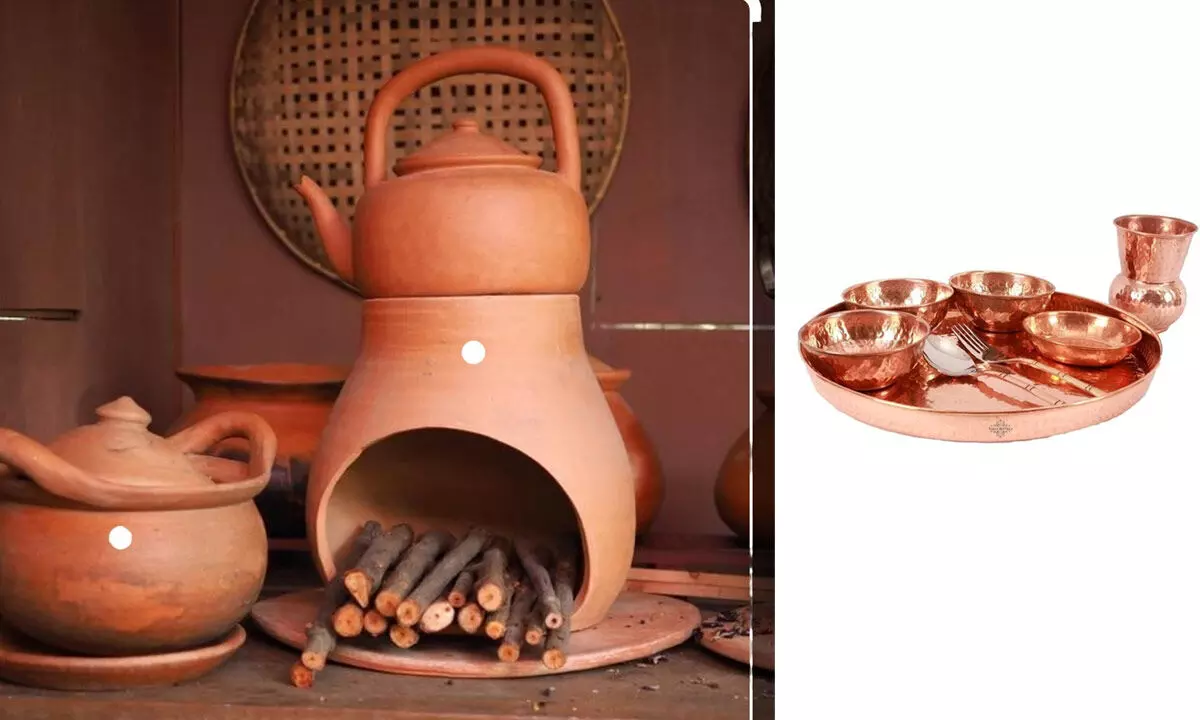Timeless Appeal of Bharat’s Traditional Crockery

Recently, a viral Instagram reel showcased a brass container containing a compact, portable crockery set, sparking widespread curiosity and admiration.
Recently, a viral Instagram reel showcased a brass container containing a compact, portable crockery set, sparking widespread curiosity and admiration. The idea of crafting a set of vessels designed for both cooking and serving in such a compact form amazed many, especially the younger generation. However, this innovation is not new. It has its roots in the rich history of traditional Indian cookware, dating back to the Saraswati Valley Civilization. These ancient utensils, made from materials like clay, brass, copper, stone, and wood, were not just functional; they were deeply intertwined with the socio-economic and cultural fabric of the time.
The types of vessels used in ancient India tell us much about the lifestyles of the people, including the kinds of food they consumed, the quantities they cooked, and the methods of food storage. Each material—whether clay, brass, copper, stone, or wood—was selected based on the region’s climate, topography, food habits, and availability of resources. These materials were not just chosen for their availability but also for their ability to enhance the taste and nutritional value of the food.
Nowadays, there has been a resurgence of interest in traditional Indian crockery, particularly clay pots. These pots, whether matkas, handis, or kadais, have found a place in the kitchens of those who seek to recreate traditional Indian dishes like matka kulfi, handi biryani, and kadai sabji. However, the challenge lies in the quality of the soil used to make these clay pots. Today, the soil is often contaminated with heavy pesticides and insecticides, which can leach into the food being cooked or stored in these pots, posing significant health risks.
The use of traditional materials like clay requires a holistic approach to health and sustainability. It is not enough to simply replace modern cookware with clay pots without understanding the broader implications. For instance, the maintenance of clay pots in modern kitchens often involves the use of chemical-based soaps, which can negate the benefits of using natural materials. In the past, clay utensils were cleaned with natural substances like coal dust or mud, which preserved their integrity and health benefits.
Another important consideration is the type of clay used. Not all clay is beneficial for health. For instance, Bentonite clay is known for its internal and external health benefits, but it is not recommended for pregnant women or older people due to certain limitations. Therefore, it is crucial to be aware of the specific properties of the clay used in making cookware.
Similarly, while brass and copper vessels are celebrated for their ability to conduct heat and enhance the flavour of food, they are not suitable for all types of cooking. These metals can react with certain food ingredients, leading to the formation of harmful compounds. For example, brass can react with salt and acidic foods, potentially leading to food poisoning. In ancient times, the knowledge of which materials to use for specific types of cooking was passed down through generations. Our grandmothers possessed a deep understanding of the chemistry of metals, a traditional knowledge that dictated which food combinations were safe and which could cause harm.
Stone cookware, another traditional material, was primarily used for grinding. Stones contain natural minerals that can enhance the flavour and nutritional value of food. Today, we see a revival of interest in slow-cooking foods and stone slab cooking, both of which harken back to ancient practices. Stoneware is particularly valued for its ability to provide slow, even heat, which brings out the natural flavours of food and maintains consistent temperatures for long-cooked dishes.
Wooden utensils, while not typically used for cooking, played an essential role in traditional Indian kitchens. Wooden bowls, spoons, and chakkis (hand-operated mills) were used for serving and preparing food. Wooden utensils add a subtle, natural flavour to food, especially when used for mixing or serving. They are gentle on delicate foods, preserving their texture and enhancing their taste.
Traditional cookware materials were not just about practicality; they also played a vital role in enhancing the flavour of food. Clay pots, for example, are known for their ability to retain moisture and steam, which enhances the flavour of slow-cooked dishes. Brass and copper cookware conduct heat evenly, adding a distinct metallic flavour to dishes, particularly those with spices and acidic ingredients. Copper, in particular, has the ability to ionize with water, preserving the nutritional content of food. Stoneware allows for slow, even heating, which helps to bring out the natural flavours of food. Wooden utensils, on the other hand, contribute a subtle, natural flavour, especially when used for serving or mixing.
In contrast, modern cookware materials, including aluminum, non-stick surfaces, plastic, and stainless steel, often pose health risks. Aluminum, while lightweight and heat-efficient, can react with acidic foods, potentially leading to neurological disorders. Non-stick pans, particularly those coated with Teflon, can release toxic fumes and chemicals at high temperatures. Plastic utensils and containers are another concern, as they can leach harmful chemicals like BPA and phthalates into food, leading to health problems such as hormonal imbalances and cancer. Stainless steel, though durable and generally safe, can leach nickel and chromium into food, especially when cooking acidic dishes, posing health risks when consumed in high levels.
The shift from traditional to modern crockery has had a profound impact on the taste, nutritional value, and safety of the food we consume. While modern materials offer convenience and durability, they often lack the ability to enhance the flavour and quality of dishes in the way that traditional materials did. Reviving traditional cookware practices could bring back forgotten flavors and promote healthier cooking methods, reconnecting us with the wisdom of our ancestors and the natural benefits of using materials that are in harmony with our bodies and the environment.

















